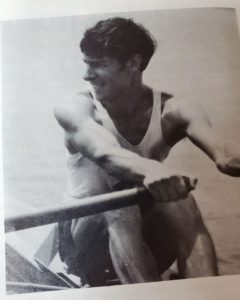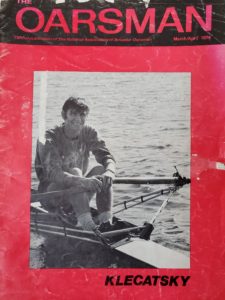By Jim Dietz
Larry Klecatsky was the most driven man that I have known. When it came to family, doctoring and sculling he did not compromise. He was all systems go all the time. I only knew Larry a few times as a physician. He would take time out of his day to stitch me up in his home after work accidents or while acting as Team Doctor in Europe, (most notably attending to me at the world championships in Moscow in 1973.) His family was with him at most regattas. But it was on the water that I knew him the best. Larry led by example. Every oarsman and oarswoman at the New York Athletic Club (NYAC) was inspired by Larry and he (without really knowing it) propelled our club to become among of the strongest sculling clubs in the country.
Larry started his rowing and sculling in 1957 at St. Paul’s high school with his brothers and sister at the Minneapolis Rowing Club. His young sculling days saw little success in Minnesota, mostly due to the cold and frigid winters that kept many waterways frozen until late April or May. Many an old timer that I have spoken with would say that if Larry was in your race back then you were guaranteed not coming in last. He graduated from St. Thomas College in St. Paul in 1963.

Photograph taken from The Oarsman, March/April 1974
It was when Larry was at medical school at the University of Minnesota that he first started to emerge as a competitive sculler. You would think that as a medical student Larry would have had little time for sculling, but Larry was not your typical medical student. Blessed with a type A personality, Larry was able to blend into each day the hours of study and the hours of miles necessary to be successful. Luck, or rowing providence saw Larry go on to do his residency at a hospital in Philadelphia where he rowed out of Bachelors Barge Club. Once on the warmer Schuylkill River he logged even more miles. It’s these miles that he amassed in the following years that would prove to be the best way to develop an athlete in a high-performance sport like rowing. I’m not sure if Larry was creating a new training model at that time, or that he just loved to row long slow distance. Larry’s time on the water seemed to be working for him and he would be at the club both before and after work each day. He gained technical perfection and aerobic superiority winning his first national championships in those residency years. Larry finished his residency and because he was funded by the Navy, went on to practice medicine at the Brooklyn Navy Station in NY. Providence struck again when Larry sought out NYAC to continue his sculling career and was soon sculling for our coach Jack Sulger. The commute to the club in Pelham, NY was a long one from Brooklyn but his focus was to be the fastest sculler in the country, and he paid the price of driving and sculling each day to do it.
In the mid to late ‘60s the accepted method of training was coming from Dr. Karl Adam, coach of the Ratzeburg Rowing Club in West Germany. It was a lactate tolerance method of training. Usually, short, high-intensity intervals–500 to 1,000-meter pieces at max effort, repeated several times until you could do no more. What it did was make you tough, but it also tore down the body rather than building it up. Larry incorporated this interval method into his distance training and due to the enormous base that he was amassing with this high mileage continued to build his speed year after year.
After his time in the Navy, Larry went on first to work as an emergency room physician at Lincoln Hospital in the Bronx and later moved closer to the club at Sound Shore Medical Center in New Rochelle. He wrote books on emergency room medicine and revolutionized standard emergency room practices. He was the full-time father to three boys and devoted husband when he arrived home each day.
Like most NYAC athletes, we were racing in Philadelphia every other weekend, it seemed. From the Head of the Schuylkill, Independence Day and Middle States regattas and so many more events, we were always on the Schuylkill River. Larry amassed incredible numbers of victories year after year at these great events. I can remember being relieved at the Head of the Schuylkill Regatta in 1976 when I realized that I did not have to race head-to-head against Larry that day. The singles classifications that year were based on age and Larry being 9 years older than me separated us into different races. He could win his, I could win mine and, luckily, we might win the double together.
Rowing being an outdoor sport and mother nature always having her say, victory was not always guaranteed. At one rough and windy Head of the Schuylkill, Larry and I had just rounded the corner after Columbia Bridge and were approaching the Angels statues. I remember a Vesper BC double started to overtake us on that stretch. I was working as hard as I thought I could and can remember thinking to myself “is this the end for Klecatsky and Dietz?” I said, “Larry we have to go now!” With that, Larry replied “It’s over, Jim. We’re done!” As I looked back, Larry was sitting waist deep in the river. The bow deck of our beautiful Stampfli double had torn open and we had sunk. After a chilly swim to shore, some spectators helped us lift our boat over the retaining wall and after we climbed out of the river, we walked it back to the Canoe Club. We laughed a good part of the time on the long cold walk back. Larry always said, “Sometimes you eat the bear and sometimes the bear eats you.” We would live to fight another day and that’s all part of the bigger game of life.
While Larry made his name as a lightweight, he also competed as an open weight. In 1975 he and fellow lightweight Mike Verlin represented the USA at the Pan American Games in Mexico. In 1976 (at 35 years of age) with lightweight partner Bill Belden, he raced the open 2X at the Montreal Olympics. To say that open weight scullers feared and respected him would be an understatement. If he was in the race he was there to win.
Cover of The Oarsman, Official publication of The National Association of Amateur Oarsmen, March/April 1974
Vinny Ventura, a teammate and later coach of Larry, described him best like this:
“Klecatsky was overly modest, almost shy, and not prone to talk about his accomplishments, or trying to tell other rowers how to train or how hard they should work. What he did do,” Ventura said, “was set an example, just by the way he practiced and acted.”
“We all had jobs, and worked in between training back then, and we had to be very efficient with our time,” Ventura said. “But he would always do extra miles. Nobody could match him. So, to get better, we just watched him. We watched how he worked and how he reacted in situations.”
“Larry always said, ‘The boathouse is always open. The lagoon is always open. The weight room is always open,'” Ventura recalled. “He never yelled at anyone. He would just say, if you want to get better, work harder.” Work harder, and let deeds speak for themselves was something that marked Klecatsky’s life”.
Larry refused to row in master’s events in his later years. At the Head of the Charles, Schuylkill, and Canadian Henley, he continued to enter the Elite events as long as he was competitive. He could have easily dominated the old boy events but never the pot hunter, preferred to push the younger scullers and himself to the limit. In 1991 he finished 4th in the Elite lightweight single at The Canadian Henley. He was called into the finish line along with the winner of the race to be honored by the Henley Regatta. Larry was 50 years old and it was his birthday. The younger scullers were in awe!
As a college coach, I often had the conversation with an athlete who would come into my office and say “Coach, I have to quit the team, there is not enough time in the day to train and do my studies and I hope to go on to medical school after graduation.” I would tell those student athletes about Dr. Larry Klecatsky and how he was able to do it all. He went after his dreams and had an incredibly productive life. He had it all and lived his life to the fullest!
In 1978, Larry was inducted into National Rowing Hall of Fame and subsequently the New York Athletic Club Hall of Fame in 1989. Larry died in 2019 at the age of 77. I was honored to carry his ashes with me for one last race at the Head of the Charles that year.
On his locker at the NYAC was a sticker “Pain is weakness leaving the body.” He also described rowing as “98% perspiration 2% inspiration.” For those of us watching him scull it was all inspiration!
The Cat was a legend!
~ His partner, Jim Dietz
We are celebrating the HOSR’s 50th anniversary by highlighting 50 legendary competitors/crews/teams/coaches/influencers that have catapulted the regatta into a fall classic over the last 50 years. We celebrate the people by passing down their stories through generations, and affecting change for the future of our sport. We will publish a new story each week, continuing the celebration of our 50th anniversary, leading up to the 2021 regatta.


